Heating is the supplying of heat to a building, vehicle, or other enclosure to make the occupants comfortable. This article deals with the heating of houses and other buildings.
Most people feel comfortable in a room with a temperature of 68 to 75 °F (20 to 24 °C). The humidity in a room also affects comfort. If two rooms have the same temperature but different humidity, most people will feel warmer in the room with the higher humidity. An indoor relative humidity of 30 to 70 percent is the most comfortable for most people (see Humidity ).
The temperature in a home can be lower without sacrificing comfort for some people if moisture is added to the air with a device called a humidifier. However, adding the moisture may require more energy than merely raising the temperature.
There are two kinds of heating equipment, central heating systems and local heating devices. A central system generates heat for an entire building at a central place, then delivers the heat where it is needed. A local heating device, such as a stove or room heater, produces heat for only one part of a building. Central heating systems are much more common in industrialized countries than in developing nations.
Central heating systems
Most central heating systems serve only one building. However, some systems heat a group of buildings, such as those at a college, a military base, or an apartment complex.
Central heating systems have automatic controls, with a device called a thermostat to regulate the temperature of the rooms heated by the system. A person sets the thermostat at the desired temperature. The thermostat turns the system on when the temperature drops below the setting, and turns the system off when the temperature rises above the setting. Another automatic control turns off the central heating system if any part of it becomes dangerously overheated. Yet another control prevents the system from starting unless it can start safely.
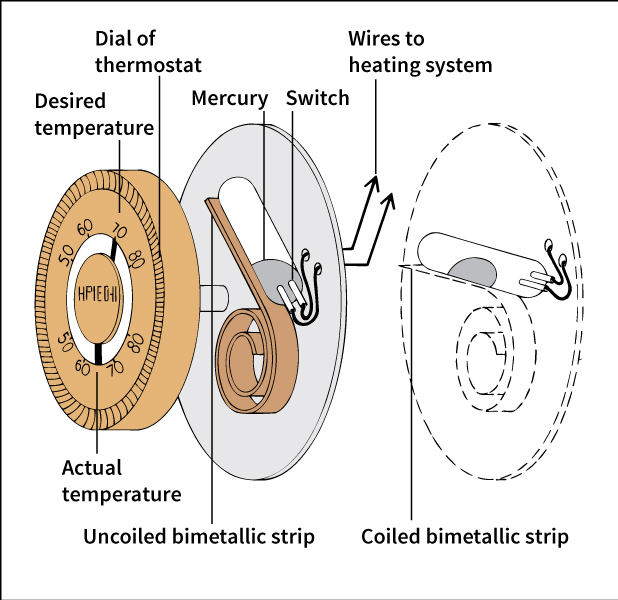
The major kinds of central heating systems include (1) warm-air heating, (2) heat pumps, (3) steam and hot-water heating, (4) electric radiant heating, and (5) solar heating. Warm-air heating and heat pumps are direct systems—that is, they circulate warm air throughout the area being heated. The other major systems are indirect. They run steam or hot water through pipes, or electric current through cables, to radiators that give off heat.
Warm-air heating.
A warm-air heating system warms the air in a furnace and then forces the air through a system of ducts to each room. Another system of ducts carries air from the rooms back to the furnace. An electrically driven blower in the furnace moves the air through the ducts, and filters remove dust particles from the air.
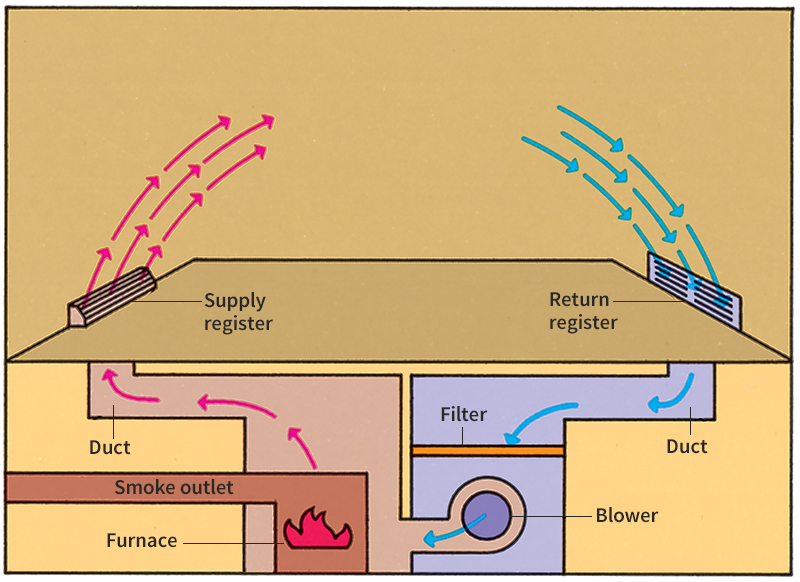
The adaptability of warm-air systems makes them a popular form of central heating. A forced warm-air system with a humidifier, for example, can increase humidity throughout the home. In hot weather, the system’s ducts and blower can serve as part of a central air-conditioning system.
Heat pumps.
Even in cold weather, the earth or outside air contains heat that can be used to warm a building. A device called a heat pump takes heat from the outside air or the ground and brings it inside. In winter, a heat pump circulates a liquid refrigerant through a coil, called an evaporator, outside the building. As the cold liquid passes through the coil it picks up heat from the outside air or earth, boils, and becomes a vapor. The vapor then passes into a compressor. The compressor increases the temperature and pressure of the vapor. Then the hot vapor passes through an inside coil, called a condenser, where it heats the air and condenses into a hot liquid. The hot liquid then goes through a pressure-reducing valve and becomes cold again. Finally, the refrigerant is forced back to the outside coil and the cycle begins again. Heat pumps are built into many warm-air heating systems, serving as a source of heat.

During the summer, heat pumps reverse their operation. They cool the building by pumping heat from the inside to the outside.
Steam and hot-water heating systems.
Many large buildings use steam or hot-water heating systems. These systems cost more than warm-air systems but have certain advantages. The pipes carrying steam or hot water are smaller than warm-air ducts. Automatic valves can control the flow of hot water or steam to convectors (devices that spread heat) and other types of radiators more easily than they can control warm air. Thus, it is easier to control the temperature in different rooms with these systems than with warm-air heating.
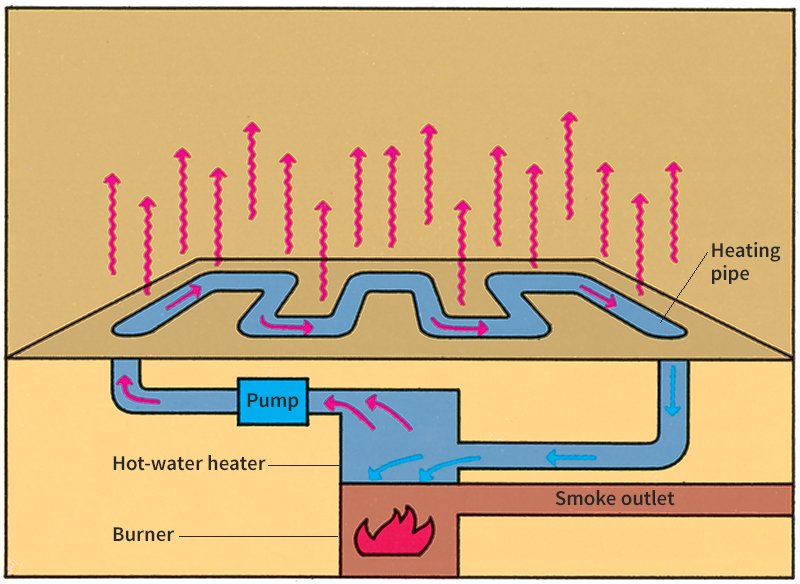
A steam heating system requires a tank for making steam called a boiler. A hot-water heating system also uses a tank to heat water called a hot-water heater or, in many countries, a boiler. Fuel burning in the bottom of the tank produces heat for the system. The system also has a network of pipes and convectors. A pump or gravity circulates the steam or water through the system.
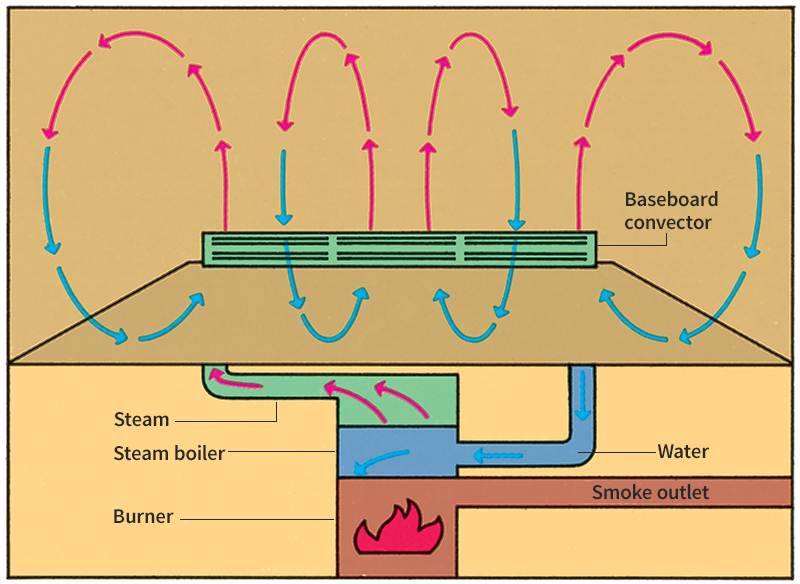
The convectors of a steam or hot-water system give off their heat by convection and radiation. In convection, the convector heats the surrounding air. In radiation, the convector sends out infrared rays, which heat objects in the room. Infrared rays are much like light waves but are invisible. Infrared rays can go through air without heating it. But when the rays strike an object, such as a table, a chair, or even a person’s skin, they heat the object.
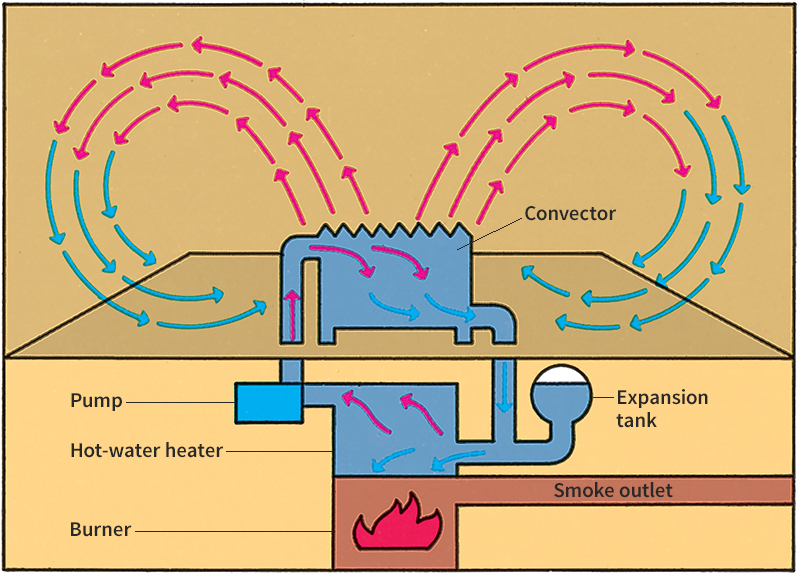
The amount of heat given off by radiation depends on the temperature and surface area of the convector. With lower temperatures typical of hot-water heating, more heat is delivered by convection than by radiation. The amount of heat given off by a convector depends upon its shape, its color, and the amount of exposed metal surface. The more metal that is exposed, the more heat is given off.
One difficulty in heating with high temperature convectors alone stems from the fact that warm air rises. Thus, the air near the ceiling becomes warmer than the air in other parts of the room. For example, the air at knee height may be 64 °F (18 °C), the air at the breathing level may be 68 °F (20 °C), and the air at the ceiling may be 72 °F (22 °C). The air at the floor level may be only 60 °F (16 °C). Such a floor temperature is too low for comfort. If the temperature of the floor is raised, the average room temperature increases and the upper parts of the room become uncomfortably warm.
Radiant heating equalizes temperature within a room. A loop of hot-water pipe is installed in the ceiling or floor. Heat leaves the pipe by radiation, which does not directly raise the temperature of the air. Because radiation affects only the objects it strikes, it produces more uniform heating than convection does.
Radiant heat provides comfort at a lower room temperature than other heating systems. Such heat warms the surface of the skin and clothing and makes people comfortable even in a cool room.
Radiant heating also may be installed along the baseboards of a room. One system uses a metal shield about 6 inches (15 centimeters) high to cover a hot-water pipe that runs close to the floor. Such a system distributes heat evenly. All radiant heating systems limit the temperature difference between the floor and the ceiling to only a few degrees.
Electric radiant heating
differs from other central heating because it requires no combustion of fuel in the building being heated. Instead, the electric power comes from a plant that may be far away.
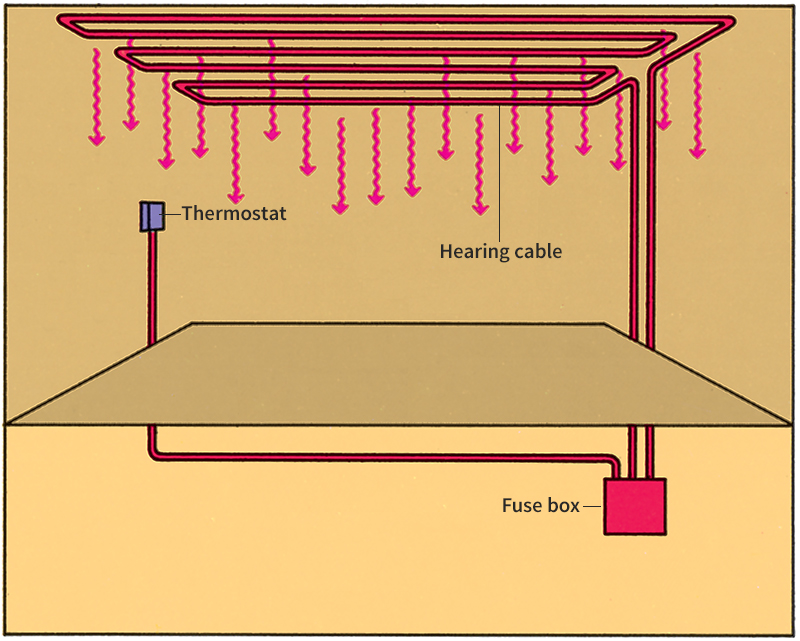
An electric heating unit uses resistance heating. An electric current passes through a material that strongly resists the flow of current. As a result, the current heats the material. The heating units may be installed in the ceiling, in the floor, or along the baseboards of a room. Thermostats in the various rooms of a house can control heating units to regulate room temperature individually.
Solar heating
uses sunlight as a heat source. In one method, sunlight heats devices called solar collectors. Fluid inside the collectors flows to a heat exchanger, where the fluid transfers its heat to water. The heated water is used to heat the building as in other hot-water systems. See Solar energy (Solar heating) .
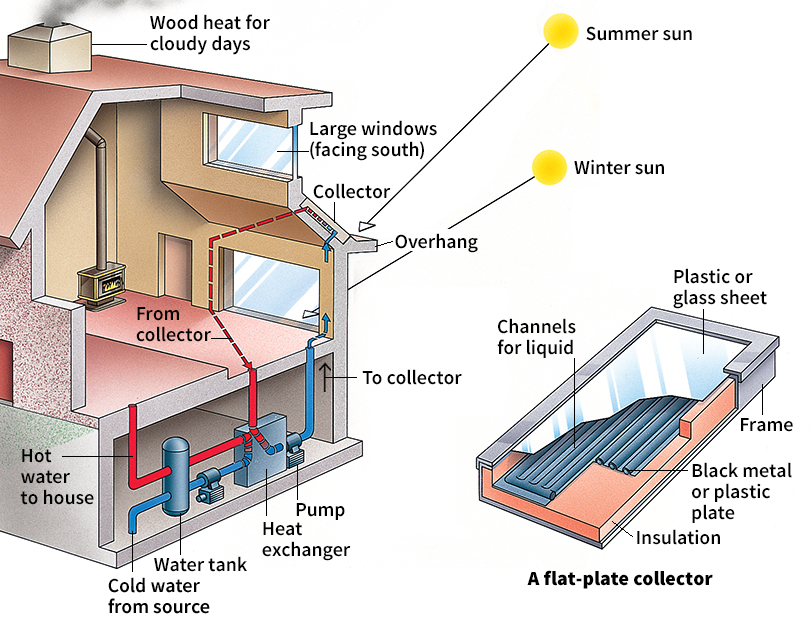
Windows may be designed so that the infrared rays in sunlight can pass into a building but not out again. The rays heat objects inside the building, and little heat from inside is lost through the glass.
Sources of heat
Most homeowners heat with gas, oil, or electric power. At one time, many private homes were heated with coal. But gas, oil, and other fuels have largely replaced coal in homes because they are more convenient and produce less pollution.
Gas
produces heat with little air pollution. Nearly all the gas used for heating homes is either natural gas or LPG (liquefied petroleum gas). Natural gas comes from underground rock formations, as does oil. Most natural gas reaches homes through pipelines.
Many people who live in mobile homes or in rural areas far from gas pipelines use LPG. This fuel is produced by pressurizing certain compounds in natural gas or gaseous compounds taken from petroleum. Farm suppliers deliver LPG to the users in small pressurized containers. A valve feeds LPG from the container into a pipe. When the LPG leaves the container, it changes back into a gas. It then flows through the pipe to a furnace.
Gas is simple to burn. The furnace pipes the fuel to individual burners, where combustion takes place.
Oil.
Fuel oil used for home heating comes from the refining of petroleum. Local trucks deliver the oil to homes, where it is stored in tanks until used. A home oil furnace has either a pot-type (or vaporizing) burner or a gun-type (or atomizing) burner. In a pot-type burner, the fuel flows into a shallow depression in the bottom of the furnace. In a gun-type burner, the oil is sprayed through a nozzle under air pressure. The burner uses an air pump to vaporize the fuel. The added air makes the oil burn more efficiently.
Electric power
provides convenient, comfortable heating. Resistance electric heating is safe and clean, and it does not pollute the air in and around the home. Installing and maintaining the equipment is also inexpensive. But resistance electric heating is less efficient and usually more costly than other heating methods.
Electric storage heaters help reduce costs. These heaters use electric power to generate large amounts of heat during late-night hours when rates are lower. The units store heat in a solid or liquid material. Many use bricks for this purpose. During the daytime, the units use the stored heat to maintain comfortable room temperatures without additional electric power.
Most of the electric power plants in the world are much less efficient than are oil or gas heaters in the home. Electric power plants that burn gas, oil, or coal provide about 63 percent of the world’s electric power. Such plants use about three units of energy for each unit of heat that is delivered to the home.
A gas or oil heating system in the home can convert 70 to 90 percent of the energy it uses into heat. If electric power is to be used, builders recommend an electric heat pump because it delivers about three units of heat for each unit of energy it uses.
Coal.
People in many areas, especially in Asia and Europe, use coal or coke, a solid fuel made from coal, to heat homes and buildings. The burning fuel either heats air that is forced through ducts, or it is used to make steam that flows to convectors.
Coal for heating comes in several grades, depending on its heating capability and carbon content. The two most common types of coal used for heating are anthracite (hard coal) and bituminous (soft) coal. Anthracite produces less smoke and sulfur dioxide when burned than does bituminous coal. Coke, which contains nearly 90 percent carbon, produces intense, smokeless heat.
Local heating devices
Local heating devices are commonly used in many regions. Such devices include fireplaces, wood-burning stoves, and room heaters.
Fireplaces.
The earliest type of local heating device was the open fire within an enclosure, such as a cave or a tent. Such a fire is not satisfactory because the area soon fills with smoke. In addition, an open fire without a chimney lacks enough draft to burn brightly.
If a fireplace is put at one side of a room and provided with a chimney, the smoke and combustion gases pass up the chimney. The chimney provides a draft by which the air enters the front of the fireplace and passes up the chimney to aid the burning of the fuel. But this draft reduces the energy efficiency of a fireplace.
A typical fireplace allows enough warm air to escape through the chimney to empty an average room every few minutes. Because of this air leak, a fireplace may contribute little to the heating of a room in a house that has a central heating system. Both the fireplace and the central heating warm the room. However, the fireplace may add only a little more heat than it allows to leak out.
Wood-burning stoves
were widely used for cooking and heating before the development of gas and electric ranges and central heating systems. In the 1970’s, the stoves again became popular in some rural areas, where wood is plentiful. In such areas, the stoves may provide cheaper heat than do oil-burning systems. However, smoke from wood-burning stoves pollutes the air, and some countries and communities restrict their use.
Most wood-burning stoves are made of heavy cast iron or steel. Air inlets in the front of the stove control the draft and help burn wood more efficiently than in an open fireplace. When the stove becomes hot, it holds heat better than a fireplace does. Fireplace inserts are stoves that fit into a fireplace.
Room heaters.
Some room heaters burn gas, kerosene, or coal to produce heat. These heaters can be placed in a corner of the room and used with a fan to circulate the air. However, the burning of these fuels may produce deadly carbon monoxide gas. To guard against carbon monoxide poisoning, use fuel-burning heaters only with adequate venting to the outside.
Electric room heaters pass an electric current through a series of wires. These wires strongly resist the flow of current and therefore become hot. An infrared heat lamp, which uses a special light bulb to produce infrared rays, can be used to heat a small area. Electric heaters and infrared heat lamps are used in bathrooms, bedrooms, workshops, and other spaces. Such heating devices can cause serious burns, so install them where no one will touch them accidentally. Keep room heaters at least 3 feet (0.9 meter) away from furniture or other combustible material, such as curtains and bedding.
Most local sources of heat are hotter than steam and hot-water radiators. For this reason, they produce a larger proportion of radiant heat. When such large amounts of radiant heat are used, the temperature of the air in the room need not become so high. For example, a resistance-type electric heater called a quartz heater warms anyone in the path of its heat rays. But the heat rays do not warm the air through which they travel.
History
Early people used fire to keep warm. They often built fires inside or near their shelters for warmth. Some buildings in ancient Rome were heated by a hypocaust. This system generated heat in a special fire room and circulated it under the floor and between double walls.
People throughout the ages have made various types of heating stoves. People in China probably used cast-iron stoves as early as 100 B.C. In the A.D. 700’s, people in northern China began using earthenware stoves for heating. Europeans began to make brick stoves in the early 1400’s and cast-iron stoves in the early 1600’s. Early cast-iron stoves were little more than iron boxes with lids. The American inventor and statesman Benjamin Franklin developed the Franklin stove in the early 1740’s. This stove, a cast-iron enclosure, fitted into a fireplace. It extended into the room so that three sides gave off heat.
As early as 1777, inventors devised small-scale systems that heated rooms by circulating hot water through a series of pipes. In 1784, the Scottish engineer James Watt devised a small steam-heated radiator system to heat his office. The first practical coal stove, called a baseburner, was patented in 1833 by Jordan L. Mott, an American inventor. It had ventilation so it could burn coal efficiently. The first large-scale central heating system was installed in a silk factory in Watford, England, around 1820. This system used a steam boiler and distributed heat through a network of cast-iron pipes. By the mid-1800’s, power-driven fans distributed heat from steam-heat systems through ducts in many buildings. Gas heating came into use in many cities during the early 1900’s.
